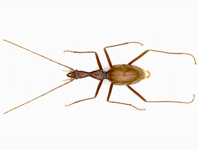Abstract
Eimeria pileata Soriano-Vargas, Medina, Salgado-Miranda, García-Conejo, Galindo-Sánchez, Janczur, Berto and Lopes, 2015 is a junior homonym of Eimeria pileata Straneva and Kelley, 1979 and needs to be replaced. This coccidium was described from a rufous-capped brush finch Atlapetes pileatus Wagler in the Nevado de Toluca Natural Protected Area, Mexico. Thus, to maintain the original intent of the specific epithet derived from the scientific name of the type-host, the name Eimeria atlapetesi nom. nov. is proposed as a replacement name. Additionally, the current work reports another rufous-capped brush finch A. pileatus parasitized by E. atlapetesi in co-infection with an Isospora sp., providing observations of histopathology and phylogenetic analysis of 18S ribosomal RNA (rRNA) gene from E. atlapetesi. Endogenous forms of E. atlapetesi and Isospora sp. were observed in intestinal sections. Few oocysts of Isospora sp. were observed; therefore they were not morphologically or molecularly identified. In return, E. atlapetesi was identified and it was phylogenetically close to Eimeria dispersa Tyzzer, 1929 from the domestic turkey Meleagris gallopavo Linnaeus.
References
Altschul, S.F., Madden, T.L., Schaffer, A.A., Zhang, J., Zheng, Z., Miller, W. & Lipman, D.J. (1997) Gapped BLAST and PSI-BLAST: a new generation of protein database search programs. Nucleic Acids Research, 25, 3389–3402.
https://doi.org/10.1093/nar/25.17.3389AVMA (American Veterinary Medical Association) (2013) AVMA guidelines for the euthanasia of animals. Available from: https://www.avma.org/KB/Policies/Documents/euthanasia.pdf (accessed 19 October, 2015)
Berto, B.P., Flausino, W., McIntosh, D. & Lopes, C.W.G. (2011) Coccidia of New World passerine birds (Aves: Passeriformes): a review of Eimeria Schneider, 1875 and Isospora Schneider, 1881 (Apicomplexa: Eimeriidae). Systematic Parasitology, 80, 159–204.
https://doi.org/10.1007/s11230-011-9317-8Berto, B.P., McIntosh, D. & Lopes, C.W.G. (2014) Studies on coccidian oöcysts (Apicomplexa: Eucoccidiorida). Revista Brasileira de Parasitologia Veterinária, 23, 1–15.
https://doi.org/10.1590/S1984-29612014001Box, E.D. (1981) Isospora as an extraintestinal parasite of passerine birds. Journal of Protozoology, 28, 244–246.
https://doi.org/10.1111/j.1550-7408.1981.tb02842.xDeSante, D.F., Sillet, T.S., Siegel, R.B., Saracco, J.F., Romo de Vivar Alvarez, C.A., Morales, S., Cerezo, A., Kaschube, D.R., Grosselet, M. & Mila, B. (2005) PIF Asilomar Proceedings. MoSI (Monitoreo de Sobrevivencia Invernal): Assessing habitat-specific overwintering survival of Neotropical migratory landbirds. In: Ralph, C.J. & Rich, T.D. (Eds.), Bird Conservation, Implementation and Integration in the Americas. USDA Forest Service General Technical Report, PSW-GTR-191. [unkown pagination]
Duszynski, D.W. & Wilber, P. (1997) A guideline for the preparation of species descriptions in the Eimeriidae. Journal of Parasitology, 83, 333–336.
https://doi.org/10.2307/3284470International Commission of Zoological Nomenclature [ICZN] (1999) International code of zoological nomenclature [the Code]. The International Trust for Zoological Nomenclature, c/o Natural History Museum, London, xxix + 306 pp.
Lindsay, D.S., Dubey, J.P. & Blagburn, B.L. (1997) Biology of Isospora spp. from humans, nonhuman primates, and domestic animals. Clinical Microbiology Reviews, 10, 19–34.
Marquardt, W.C. (1981) Host and site specificity in the coccidia: a perspective. Journal of Protozoology, 28, 243–244.
https://doi.org/10.1111/j.1550-7408.1981.tb02841.xMedina, J.P., Salgado-Miranda, C., García-Conejo, M., Galindo-Sánchez, K.P., Mejía-García, C.J., Janczur, M.K., Gomes Lopes, C.W., Berto, B.P. & Soriano-Vargas, E. (2015) Coccidia in passerines from the Nevado de Toluca National Park, Mexico. Acta Parasitologica, 60, 173–174.
Norma Oficial Mexicana [NOM-033-SAG/ZOO-2014] (2015) Métodos para dar muerte a los animales domésticos y silvestres. Diario Oficial de la Federación. Secretaría de Agricultura, Ganadería, Desarrollo Rural, Pesca y Alimentación, México, 47 pp.
Rice, P., Longden, I. & Bleasby, A. (2000) EMBOSS: the European Molecular Biology Open Software suite. Trends in Genetics, 16, 276–277.
https://doi.org/10.1016/S0168-9525(00)02024-2Sánchez-Jasso, J.M., Aguilar-Miguel, X., Medina-Castro, J.P. & Sierra-Domínguez, G. (2013) Riqueza específica de vertebrados en un bosque reforestado del Parque Nacional Nevado de Toluca, México. Revista Mexicana de Biodiversidad, 84, 360–373.
https://doi.org/10.7550/rmb.29473Soriano-Vargas, E., Medina, J.P., Salgado-Miranda, C., Garcia-Conejo, N., Galindo-Sanchez, K.P., Janczur, M.K., Berto, B.P. & Lopes, C.W.G. (2015) Eimeria pileata n. sp. (Apicomplexa: Eimeriidae) from the rufous-capped brush finch Atlapetes pileatus Wagler (Passeriformes: Emberizidae) in Mexico. Systematic Parasitology, 92, 261–265.
https://doi.org/10.1007/s11230-015-9602-zStraneva, J.E. & Kelley, G.L. (1979) Eimeria clethrionomyis sp. n., Eimeria gallatii sp. n., Eimeria pileata sp. n. and Eimeria marconii sp. n. from the red‐backed vole Clethrionomys gapperi Vigors, from Pennsylvania. Journal of Protozoology, 26, 530–532.
https://doi.org/10.1111/j.1550-7408.1979.tb04189.xTamura, K., Peterson, D., Peterson, N., Stecher, G., Nei, M. & Kumar, S. (2011) MEGA5: molecular evolutionary genetics analysis using maximum likelihood, evolutionary distance, and maximum parsimony methods. Molecular Biology and Evolution, 28, 2731–2739.
https://doi.org/10.1093/molbev/msr121Williams, R.B. (1986) Host specificity of avian coccidian. Parasitology Today, 2, 283–284.
https://doi.org/10.1016/0169-4758(86)90137-7Yang, R., Fenwick, S., Potter, A., Elliot, A., Power, M., Beveridge, I. & Ryan, U. (2012) Molecular characterization of Eimeria species in macropods. Experimental Parasitology, 132, 216–221.
https://doi.org/10.1016/j.exppara.2012.07.003

